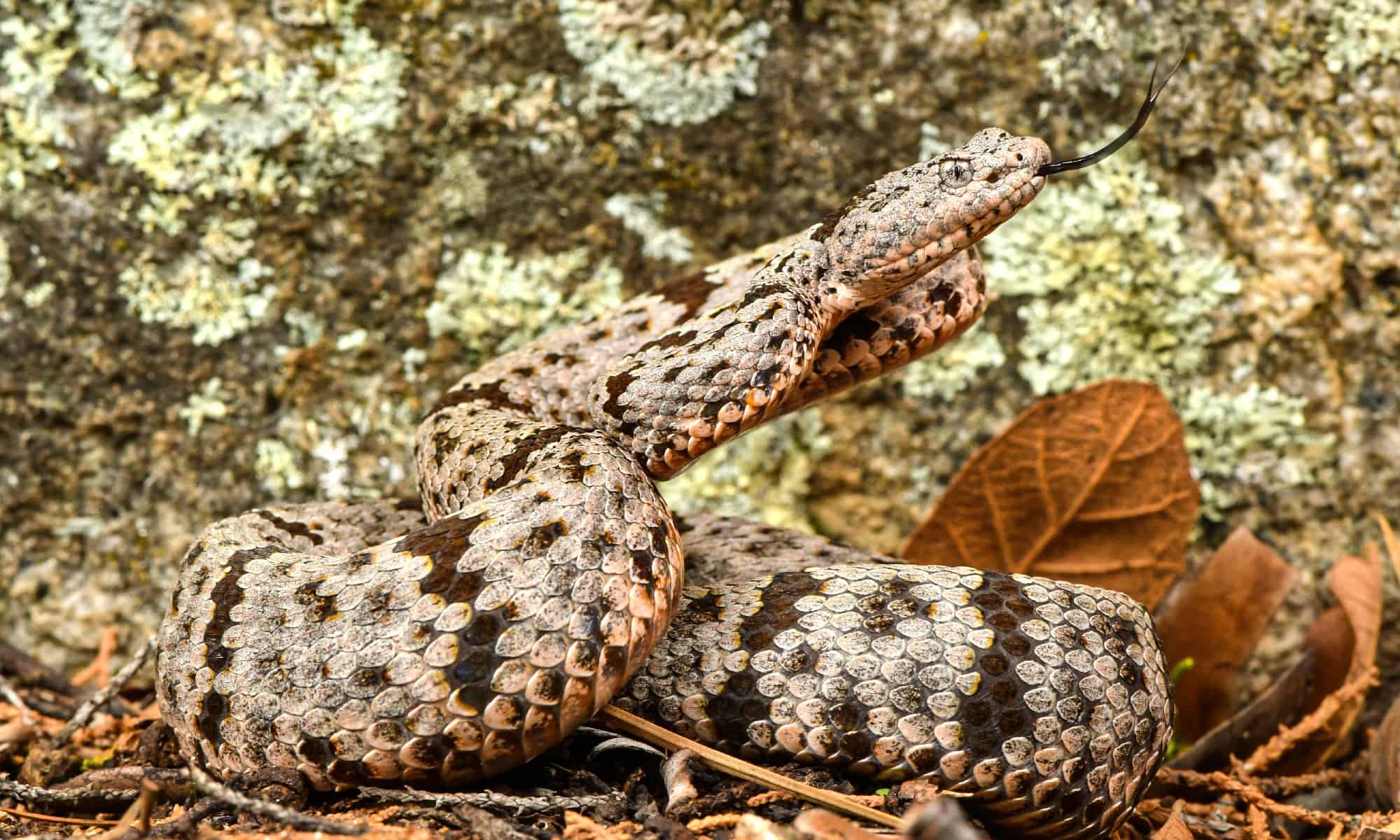Of the 36 known rattlesnake species, rock rattlesnakes (Crotalus lepidus) are one of the most distinctive. These American snakes are known by many names, such as blue rattlesnake, green rattlesnake, white rattlesnake, eastern rock rattlesnake, and Texas rock rattlesnake.
Rock rattlesnakes are pit vipers and are one of the shortest rattlesnake species in the world. As their names infer, these snakes are often found in rocky parts of the continent, sometimes even at heights of about 6,000 feet. So, what is the largest rock rattlesnake ever recorded? Find out in this article.
What is the Largest Rock Rattlesnake Ever Recorded?
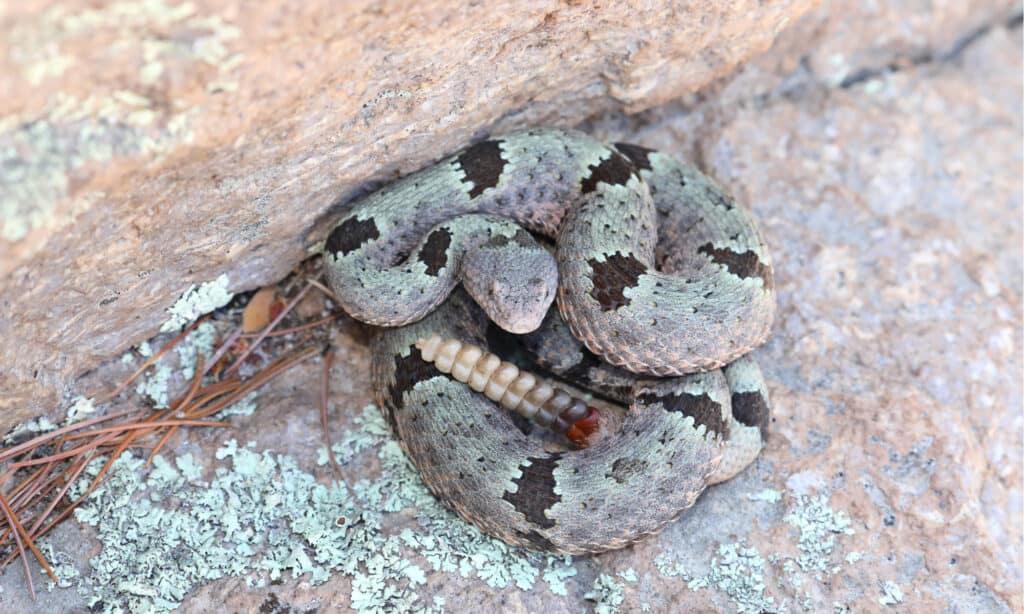
The largest rock rattlesnake ever recorded was measured to be 32 inches.
©Glenn McCrea/Shutterstock.com
These snakes are considered short rattlesnakes, growing an average length of 23 to 27 inches (1.9 to 2.2 feet). However, according to a report on GoSanAngelo, the largest rock rattlesnake ever recorded was measured to be 32 inches (2.7 feet).
What is the Largest Rattlesnake Ever Recorded?
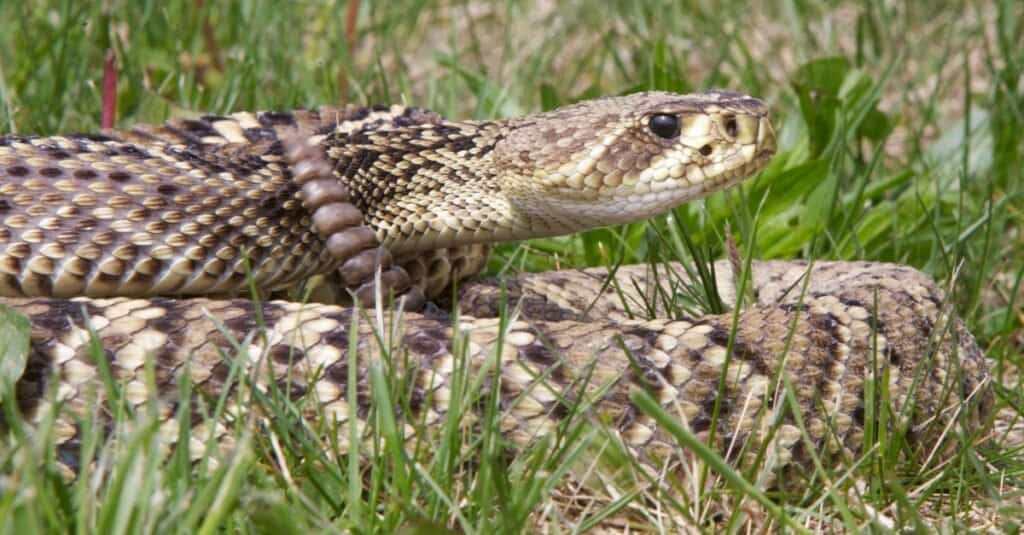
According to the Guinness World Record, the largest rattlesnake is the eastern diamondback rattlesnake.
©iStock.com/NajaShots
The largest rattlesnake ever recorded was an eastern diamondback rattlesnake which weighed 34 pounds and had a length of 7.9 feet. Eastern diamondback rattlesnakes generally weigh 13.2 pounds and grow up to 5.5 feet on average.
Where are Rock Rattlesnakes Found in America?

Rock rattlesnakes are found in Arizona, southwestern Texas, and south of New Mexico.
©Alexander Wong/Shutterstock.com
Rock rattlesnakes are mostly found in the southwestern parts of the United States, including Arizona, southwestern Texas, and south of New Mexico. Their choice of habitat is due to the many rockslides, rock crevices, outcrops, conifer forests, etc.
While rock rattlesnakes are abundant in the State of Texas, they are considered a threatened species in New Mexico. This contrasting situation is due to the lack of human access to their habitats in Texas, so their habitats are still intact and have not been displaced. They can also be found in parts of Mexico.
Are Rock Rattlesnakes Venomous?
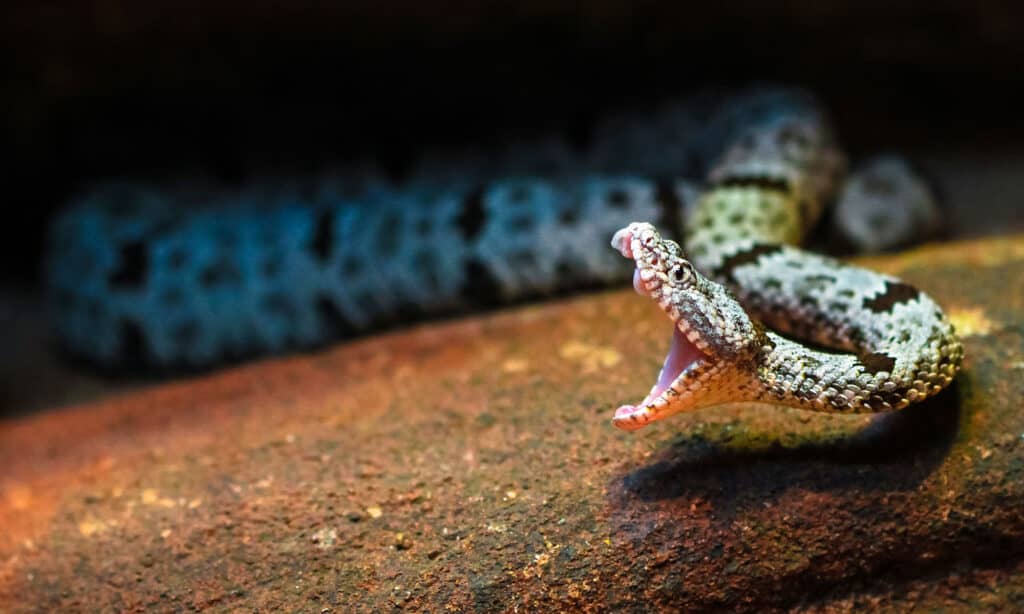
The toxins of rock rattlesnakes are known as hemotoxins.
©Kevin Wells Photography/Shutterstock.com
Rock rattlesnakes are venomous pit vipers. Their toxins are known as hemotoxins. The effects of these toxins include degeneration of organs, disruption of blood clotting, and the destruction of red blood cells. However, the venom from them still has some neurotoxic effects on humans.
The potency of their venom is due to factors such as diet and habitat. In humans, nausea, headaches, swelling around the bite, and disorientation are symptoms of a rock rattlesnake’s bite.
While there is no recorded fatality by rock rattlesnake, their attacks are still dangerous for their poisonous effects. Since they are often found far from roads and civilization, victims are often far from help.
Are Rock Rattlesnakes Aggressive?
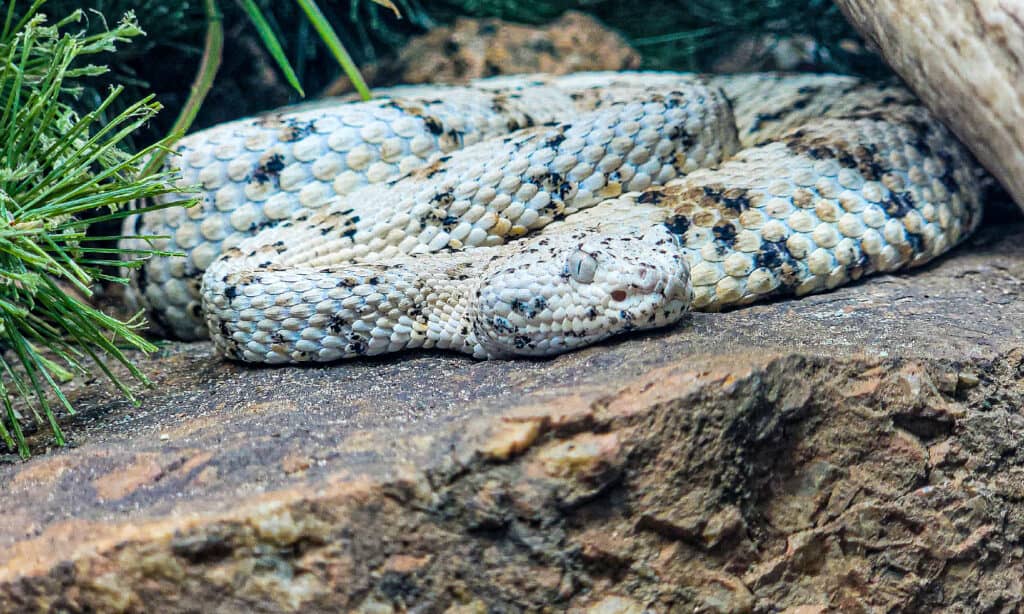
Rock rattlesnakes are not aggressive reptiles.
©iStock.com/Tyson Harriger
Contrary to popular opinions, rattlesnakes are generally not aggressive snake species. They do not attack first and sometimes do not strike at humans until handled or touched.
Rock rattlesnakes are docile snakes that depend significantly on their camouflage and would often hide or retreat when they encounter humans. They will not rattle their tails or strike at humans unless they are harassed physically.
Like most rattlesnakes, rock rattlesnake bites have been known to occur on the human feet, hands, and ankles, and their major victims are rock hikers. These attack choices are because rattlesnakes often attack when faced with no chance of retreat. Rock rattlesnakes strike when deliberately approached, stepped on, or handled, striking up to three feet from their lying position.
What Do Rock Rattlesnakes Eat?
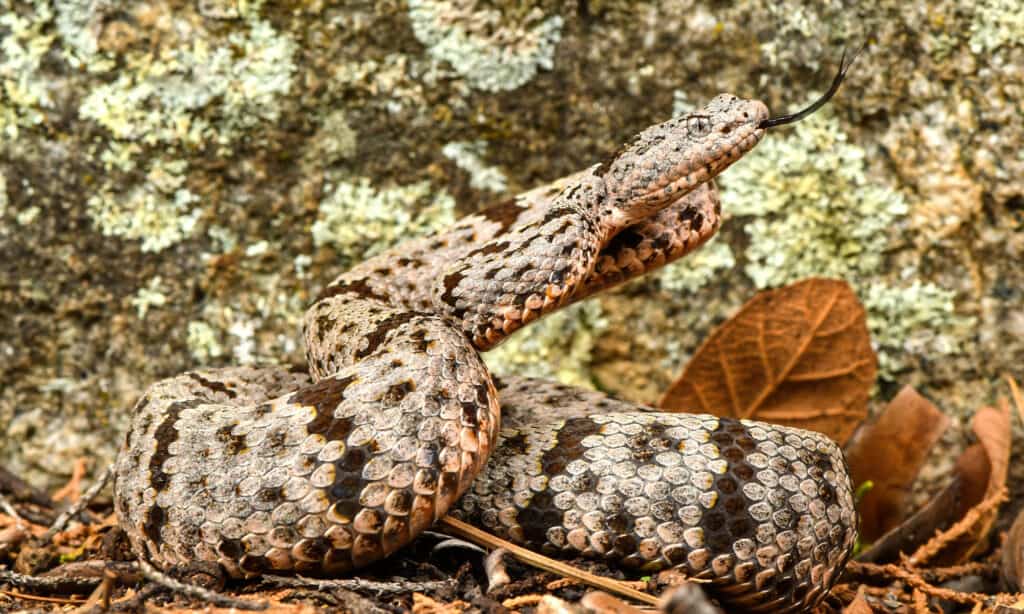
As carnivores, rock rattlesnakes eat small mammals, birds, frogs, lizards, and other snakes.
©Jon Bolton/Shutterstock.com
Rock rattlesnakes are carnivores that eat small mammals such as squirrels, mice, birds, frogs, lizards, and other snakes. Juveniles have been known to also feed on centipedes.
Though the rock rattlesnake has many teeth, they do not chew their prey. Instead, they swallow their prey whole after their venom bites have incapacitated their victims.
How Do Rock Rattlesnakes Hunt?
Rock rattlesnakes are one of the smallest rattlesnake species on the North American continent. However, this size does not restrict them from hunting down considerably larger prey. They are more active than other rattlesnake species in colder temperatures.
In the spring and fall, rock rattlesnakes are crepuscular but nocturnal in the hotter summer. They are naturally equipped to hunt all year round, and their dull grey patterns allow them to camouflage and ambush prey. Also, rock rattlesnakes can seek out prey at night through an adaptive thermal vision. They strike quickly, injecting venom into their prey, making them less resistant as the rock rattlesnakes move on to swallow their kill.
How to Identify a Rock Rattlesnake
Rock rattlesnakes are one of the smallest rattlesnake species in North America. However, their diminutive size is not enough to tell them apart from other snake species such as bullsnakes and gopher snakes.
There are several ways to tell a rock rattlesnake from bullsnakes or gopher snakes, besides the presence of a rattle and lack of one in other snake species. They have gray scales with dark gray bands along their full body lengths. Like many other rattlesnakes, their heads are broader than their necks, giving the snakes a diamond-shaped head. These vipers also have cat-like eyes and heat-sensing pits between their eyes and nostrils.
Bullsnakes and gopher snakes look similar to rock rattlesnakes but have narrower heads. While bullsnakes flatten their heads to make them look like rattlesnakes, you can tell the difference with a closer look at the heads and tails.
Rock rattlesnake sexes are distinctive in their colors. The males have a greenish mid-dorsal region and are often bigger than the females. Females have a grayish mid-dorsal region.
How Do Rock Rattlesnakes Reproduce?
Rock rattlesnakes give birth to their young alive and not in eggs, much like many other snakes. These snakes breed only once a year, in the fall, with the female rattlesnake keeping the sperm until her ovulation in spring.
The babies, often three to six, are born four months later. Females stay with the little snakes until their first shed, and they typically take three or more years to mature.
What To Do If Bitten by a Rock Rattlesnake?
If bitten by a rock rattlesnake, hurry to see a doctor. These venomous snakes can cause a lot of harm with their bites. A rock rattlesnake strikes fast and can inject venom without using its fangs to bite. There need only be an opening on one’s skin for the venom to enter and take effect.
Many factors determine the fatality of a snake bite. Some of these factors are the quantity of venom injected, time before treatment, the age of the bitten victim, and the number of bites.
There are popular myths about treating a rattlesnake bite. Some include: sucking the venom, cutting the bitten part of the body, using venom extractors, etc. While these first aid treatments sound good and effective, they are not. Sucking venom out of a bite could get the venom into your mouth and cause further complications.
Since rock rattlesnakes are found in rocky areas, there is a large possibility that you might be a long way from a road if bitten by one. The most advisable first aid treatments to apply before getting to the closest emergency center are to remove any constriction on your body, like watches, bands, tight jewelry, chokers, or rings, and to keep bitten part below the heart. You do not want the venom getting to the ‘blood pump.’
Discover the "Monster" Snake 5X Bigger than an Anaconda
Every day A-Z Animals sends out some of the most incredible facts in the world from our free newsletter. Want to discover the 10 most beautiful snakes in the world, a "snake island" where you're never more than 3 feet from danger, or a "monster" snake 5X larger than an anaconda? Then sign up right now and you'll start receiving our daily newsletter absolutely free.
Thank you for reading! Have some feedback for us? Contact the AZ Animals editorial team.

